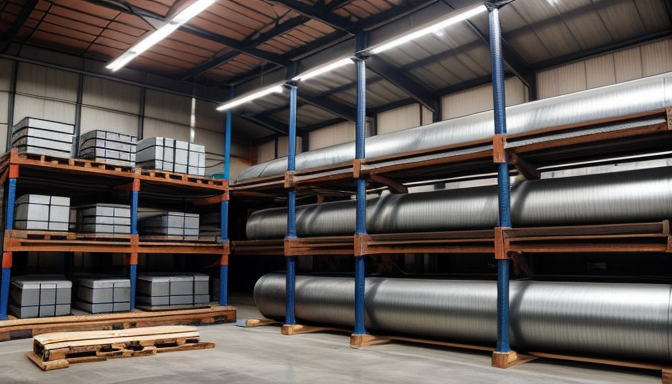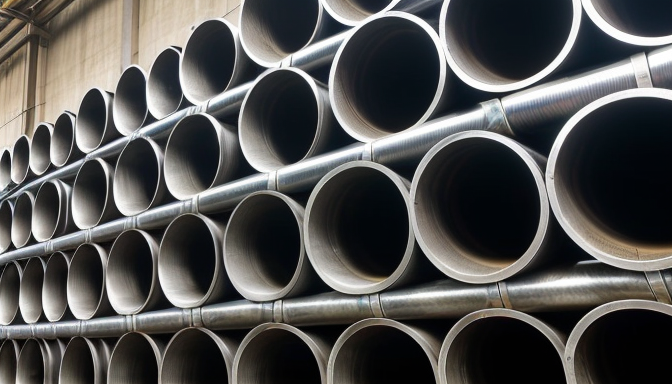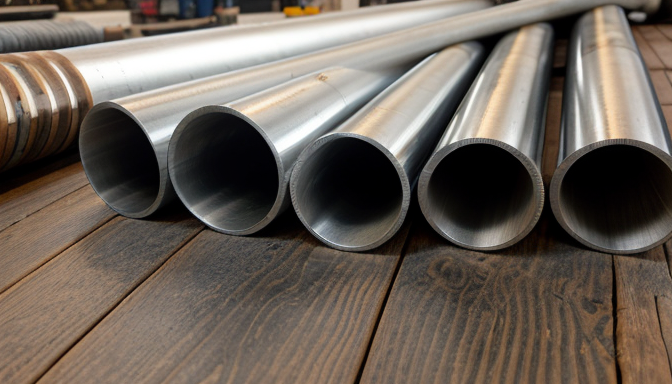When it comes to construction and manufacturing, steel pipes play a vital role. They are everywhere, from the plumbing in your home to the frameworks of skyscrapers. But what exactly makes steel pipes so important? Let’s dive into various aspects of steel pipes, including their pricing, weight, properties, sizes, and uses in different applications. Understanding these factors is essential for making informed decisions in construction and manufacturing.
The price of steel pipes can vary significantly based on several factors. Think about it: just like the price of groceries at the store, the cost of steel pipes fluctuates. Key elements influencing steel pipe pricing include:
- Material Grade: Higher quality materials cost more.
- Size: Larger pipes usually come with a bigger price tag.
- Market Demand: When demand is high, prices often rise.
It’s essential to shop around and compare prices. Sometimes, a little research can save you a lot of money.
Understanding the weight of steel pipes is crucial. Why? Because it affects transportation, handling, and structural calculations. Imagine trying to lift a heavy steel pipe without knowing its weight. You might be in for a surprise! The weight of a steel pipe is determined by its size and wall thickness. Generally, the heavier the pipe, the stronger it is. This can be a significant factor when planning a project.
Steel pipes have unique properties that make them ideal for various applications. Let’s break down some of these characteristics:
- Strength: Steel pipes can withstand high pressure and heavy loads.
- Durability: They resist wear and tear over time.
- Corrosion Resistance: Many steel pipes are coated to resist rust and corrosion.
These properties are essential when selecting the right pipe for a specific application. For instance, if you’re working on a project that involves water transport, you’ll need pipes that resist corrosion.
Steel pipes come in various sizes to accommodate different needs. This is crucial because using the wrong size can lead to project delays or failures. Standard sizes are available, but it’s important to choose the right dimensions for your specific project. Here’s a quick overview of how to select the appropriate size:
- Consider the application: What will the pipe be used for?
- Check local building codes: Some projects have specific requirements.
- Consult with a professional: When in doubt, ask an expert.
By keeping these factors in mind, you can ensure that you’re using the right steel pipe for your project.
Steel Pipe Price
The price of steel pipes can vary significantly, and understanding the factors that influence these prices is essential for anyone in the construction or manufacturing industries. Have you ever wondered why some pipes are more expensive than others? It often comes down to several key elements. For starters, the material grade plays a crucial role. Higher grades of steel, which offer better strength and durability, tend to come at a premium. Similarly, the size of the pipe affects its cost. Larger pipes require more raw material and are thus more expensive to produce.
Another important factor is market demand. When demand spikes, prices can soar. This is especially true during construction booms or when there are supply chain issues. For example, if a natural disaster strikes and there’s a sudden need for rebuilding, prices can increase rapidly. Additionally, geographical location matters. Pipes might be cheaper in some regions due to lower transportation costs or local availability.
To give you a clearer picture, here’s a simple
| Factor | Impact on Price |
|---|---|
| Material Grade | Higher grades, higher cost |
| Size | Larger sizes, higher cost |
| Market Demand | High demand, increased prices |
| Location | Transport costs affect pricing |
When purchasing steel pipes, it’s also wise to consider long-term costs. Cheaper pipes might save you money upfront, but if they fail or require frequent maintenance, they could end up costing you more in the long run. Think of it like buying a car: a less expensive model might seem appealing, but if it breaks down often, you’ll spend more on repairs than if you had invested in a reliable vehicle from the start.
In conclusion, understanding the pricing structure of steel pipes is essential. It’s not just about the initial cost; consider the overall value. By keeping an eye on these factors, you can make informed decisions that will benefit your projects in the long run. So, next time you’re out shopping for steel pipes, remember to weigh all these aspects before making your choice.

Steel Pipe Weight
Understanding the weight of steel pipes is crucial for various reasons. Why? Because it affects transportation, handling, and structural calculations. Imagine trying to move a heavy load without knowing its weight. It can lead to unexpected challenges, right? So, let’s dive into how the weight of steel pipes is determined and its implications for different applications.
Steel pipes are typically measured in terms of their diameter and thickness. These two factors play a significant role in determining the overall weight. The weight can be calculated using the formula:
Weight (Outer Diameter - Wall Thickness) x Wall Thickness x Length x Density
This formula might look a bit complex, but don’t worry! The key takeaway is that as the diameter and length increase, so does the weight. For instance, a thicker pipe will naturally weigh more than a thinner one. Think of it like comparing a straw to a garden hose. The garden hose is heavier because it has more material.
Now, let’s look at some standard weights for common sizes of steel pipes. Here’s a quick reference table:
| Pipe Size (inches) | Weight (lbs per foot) |
|---|---|
| 1/2 | 1.61 |
| 1 | 2.27 |
| 2 | 5.00 |
| 3 | 8.50 |
As you can see from the table, the weight increases as the size of the pipe grows. This is important to consider when planning for storage or transportation. If you’re working on a construction project, knowing the weight helps in selecting the right equipment for lifting and moving the pipes.
Additionally, the weight of steel pipes influences their use in various applications. Heavier pipes may be necessary for high-pressure systems, while lighter pipes can be used in less demanding environments. It’s all about finding the right balance between strength and weight. So, the next time you’re choosing steel pipes, remember: weight matters!
Steel Pipe Properties
When it comes to steel pipes, understanding their properties is key. These pipes are not just hollow tubes; they are engineered materials with unique characteristics that make them suitable for a variety of applications. Think of them as the backbone of many industries, from construction to manufacturing. So, what makes steel pipes so special?
First off, let’s talk about strength. Steel pipes are known for their remarkable strength. This means they can withstand high pressures and heavy loads without bending or breaking. Imagine trying to lift a car with a piece of spaghetti—doesn’t work, right? But with steel pipes, you can support significant weights, making them ideal for structural applications.
Next up is durability. Steel pipes are built to last. They can endure harsh weather conditions, extreme temperatures, and even corrosive environments. This durability translates into lower maintenance costs over time. Picture a sturdy umbrella that can withstand a storm—steel pipes offer that level of resilience.
Now, let’s not forget about corrosion resistance. While steel is prone to rust, many steel pipes are treated or coated to enhance their resistance to corrosion. This is crucial in industries like oil and gas, where pipes are often exposed to corrosive substances. Choosing the right type of coating can significantly extend the life of the pipe.
Here’s a quick overview of some key properties of steel pipes:
| Property | Description |
|---|---|
| Strength | Ability to withstand high pressures and loads. |
| Durability | Long-lasting performance in various conditions. |
| Corrosion Resistance | Protection against rust and degradation. |
| Flexibility | Ability to be fabricated into different shapes and sizes. |
Another important property is flexibility. Steel pipes can be manufactured in various shapes and sizes, allowing them to fit different applications. This versatility means you can find the right pipe for your specific needs, whether it’s for plumbing, structural support, or industrial use.
In conclusion, the properties of steel pipes—strength, durability, corrosion resistance, and flexibility—are what make them indispensable in many sectors. By understanding these characteristics, you can make more informed decisions when selecting the right pipes for your projects. So, the next time you see a steel pipe, remember, it’s not just a pipe; it’s a vital component that holds up our infrastructure and industry.

Steel Pipe Sizes
This article explores various aspects of steel pipes, including their pricing, weight, properties, sizes, and uses in different applications. Understanding these factors is essential for making informed decisions in construction and manufacturing.
When it comes to steel pipes, size matters. Imagine trying to fit a square peg in a round hole. It just won’t work! The right size ensures that your project runs smoothly and safely. Steel pipes come in a variety of sizes, which cater to different needs in construction and manufacturing.
Typically, steel pipes are measured by their nominal pipe size (NPS). This measurement is not the actual diameter but rather a standardized way to classify pipes. For instance, a pipe labeled as 2 inches NPS does not have an actual diameter of 2 inches. Instead, it usually measures around 2.375 inches. Confusing? Yes, but it’s essential to grasp this concept to avoid costly mistakes.
Here’s a quick breakdown of some common sizes:
| Nominal Pipe Size (NPS) | Outside Diameter (OD) in inches | Typical Wall Thickness (inches) |
|---|---|---|
| 1/2 | 0.840 | 0.109 |
| 1 | 1.315 | 0.133 |
| 2 | 2.375 | 0.154 |
| 3 | 3.500 | 0.216 |
| 4 | 4.500 | 0.237 |
Choosing the right size is not just about fitting it into a space. It’s about understanding the application. For example, larger pipes are often used for transporting water or gas, while smaller pipes might be used in residential plumbing. Each size has its own set of standards and specifications, which can vary based on the industry and local codes.
When selecting a size, consider the following:
- Flow Rate: Larger pipes can carry more fluid.
- Pressure Requirements: Ensure the pipe can handle the pressure of the application.
- Space Constraints: Always measure the installation area before purchasing.
In conclusion, understanding steel pipe sizes is crucial for anyone involved in construction or manufacturing. It’s not just about picking a number; it’s about ensuring safety, efficiency, and functionality. So, next time you’re faced with a project, remember: the right size can make all the difference!
Frequently Asked Questions
- What factors influence the price of steel pipes?
The price of steel pipes can fluctuate based on several factors, including the material grade, size, and current market demand. Additionally, global economic conditions and supply chain issues can also play a significant role in pricing.
- How do I determine the weight of a steel pipe?
The weight of a steel pipe is primarily determined by its dimensions and the density of the material. Standard weight tables are available that provide the weight per foot for various sizes and thicknesses, making it easier to calculate the total weight for your specific needs.
- What are the key properties of steel pipes?
Steel pipes are known for their impressive strength, durability, and resistance to corrosion. These properties make them ideal for a wide range of applications, from construction to manufacturing, ensuring they can withstand harsh conditions and heavy loads.
- What sizes do steel pipes come in?
Steel pipes are available in a variety of sizes to meet different project requirements. Standard sizes range from small diameters suitable for plumbing to large pipes used in industrial applications. It’s essential to choose the right size based on your specific project needs.
- Can I use steel pipes for residential plumbing?
Absolutely! Steel pipes are often used in residential plumbing systems due to their strength and durability. However, it’s crucial to consider the potential for corrosion and to select the appropriate type of steel pipe that meets plumbing codes and regulations.
